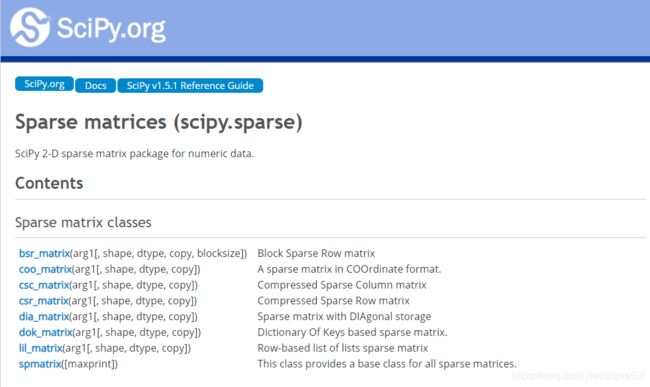Scipy 稀疏矩阵 COO、CSC、CSR
在Scipy包中,存在专门针对稀疏矩阵进行优化存储的函数,分别是COO、CSC和CSR。
之所以要使用稀疏矩阵,是因为计算所使用的数据中会存在很多无效项,所以可以转化存储方式,放弃存储无效数据,存储更多的有效数据,降低计算的复杂度。
在Scipy中有专门用于数学计算优化的package,就是scipy.sparse。而COO、CSC和CSR就是在sparse中定义的函数。
Scipy.sparse官方文档
可以看到在Sqarse matrix classes中存在三个类定义,分别是
| Sqarse matrix classes | ||
|---|---|---|
coo_matrix(arg1[, shape, dtype, copy]) |
|
|
csc_matrix(arg1[, shape, dtype, copy]) |
|
|
csr_matrix(arg1[, shape, dtype, copy]) |
|
|
从官方文档的描述上来进行理解,可以得知:
COO是coordinate的缩写,也就是说COO方法就是数据结构中记录稀疏矩阵的方法,即三元组形式。
CSC是压缩存储稀疏矩阵的类,其中的C就是指column,也就是按照列来压缩存储压缩矩阵。
CSR与CSC类似,只不过R是指row,也就是按照行来进行压缩存储。
(1)Coordinate (COO)
>>> row = np.array([0, 3, 1, 0])
>>> col = np.array([0, 3, 1, 2])
>>> data = np.array([6, 5, 7, 8])
>>> sparse.coo_matrix((data, (row, col)), shape=(4, 4)).toarray()
array([[6, 0, 8, 0],
[0, 7, 0, 0],
[0, 0, 0, 0],
[0, 0, 0, 5]])这是最简单的一种格式,每一个元素需要用一个三元组来表示,分别是(行号,列号,数值),对应上图右边的一列。这种方式简单,但是记录单信息多(行列),每个三元组自己可以定位,因此空间不是最优。
(2)Compressed Sparse Column (CSC)
>>> indptr = np.array([0, 2, 3, 6])
>>> indices = np.array([0, 2, 2, 0, 1, 2])
>>> data = np.array([1, 2, 3, 4, 5, 6])
>>> sparse.csc_matrix((data, indices, indptr), shape=(3, 3)).toarray()
array([[1, 0, 4],
[0, 0, 5],
[2, 3, 6]])CSC是按列存储一个稀疏矩阵的。其中indptr中的数据代表矩阵中每一列所存的数据在data中的开始和结束的索引,例如这里indptr为[0, 2, 3, 6],即表示在data中,索引[0, 2)为第一列的数据,索引[2, 3)为第二列的数据,索引[3, 6)为第三列的数据。而indices中的数据代表所对应的data中的数据在其所在列中的所在行数,例如,这里的indices为[0, 2, 2, 0, 1, 2],表示在data中,数据1在第0行,数据2在第2行,数据3在第2行,数据4在第0行,数据5在第一行,数据6在第2行。从而建立起一个稀疏矩阵。
(3)Compressed Sparse Row (CSR)
>>> indptr = np.array([0, 2, 3, 6])
>>> indices = np.array([0, 2, 2, 0, 1, 2])
>>> data = np.array([1, 2, 3, 4, 5, 6])
>>> sparse.csr_matrix((data, indices, indptr), shape=(3, 3)).toarray()
array([[1, 0, 2],
[0, 0, 3],
[4, 5, 6]])CSR是按行来存储一个稀疏矩阵的,其原理与CSC类似。indptr中的数据表示矩阵中每一行的数据在data中开始和结束的索引,而indices中的数据表示所对应的在data中的数据在矩阵中其所在行的所在列数。可以看出,在indptr、indices和data三个数组相同的情况下,通过CSC和CSR分别表示出来的矩阵互为转置关系。
Notes:
(1)为什么要区分行序和列序
以CSC函数为例
>>> indptr = np.array([0, 2, 3, 6])
>>> indices = np.array([0, 2, 2, 0, 1, 2])
>>> data = np.array([1, 2, 3, 4, 5, 6])
>>> sparse.csc_matrix((data, indices, indptr), shape=(3, 3)).toarray()
array([[1, 0, 4],
[0, 0, 5],
[2, 3, 6]])需要注意的是,如果是以列序为主,那么data数据的排列就是按照第一列、第二列、第三列的顺序来记录的。
也就是从第一列的第一个元素开始按照列序来生成data。
例子中的data是[1,2,3,4,5,6],这正好是矩阵array按照列序进行读取的顺序。
如果改换成这个形式:
import numpy as np
import scipy as sy
from scipy import sparse
indptr = np.array([0,2,3,6])
indices = np.array([0,2,2,0,1,2])
data = np.array([2,1,5,3,4,6])
X =sparse.csc_matrix((data, indices, indptr), shape=(3, 3)).toarray()
print(X)就得出了这个矩阵结果:
[[2 0 3]
[0 0 4]
[1 5 6]](2)后缀toarray()、tocsc()和tocsr()
确定生成的变量是什么类型的。
| 后缀类型 | 含义 |
|---|---|
| toarray() | 转换成 |
| tocsc() | 转换成 |
| tocsr() | 转换成 |
代码:
import numpy as np
import scipy as sy
from scipy import sparse
indptr = np.array([0,2,3,6])
indices = np.array([0,2,2,0,1,2])
data = np.array([2,1,5,3,4,6])
X =sparse.csc_matrix((data, indices, indptr), shape=(3, 3)).tocsr()
print(type(X))输出:
引用:
https://www.jianshu.com/p/9671c568096d
